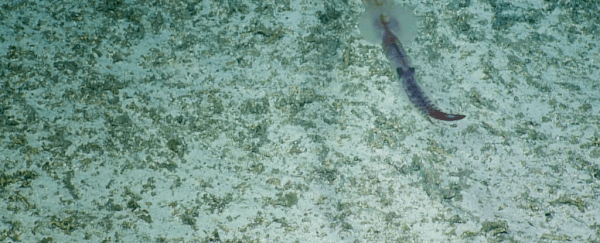There are some strange things down there, in the ocean depths, where crushing pressures and low light make for some bizarre adaptations. It's not easy for humans to get down there, but remote-controlled submarines have, in recent years, been slowly revealing to us the strange wonders at the bottom of the sea.
Like this: for the first time, the strange, deep-sea squid Asperoteuthis mangoldae has been caught on camera alive and in its natural habitat.
It was found by scientists aboard the E/V Nautilus piloting the remotely-operated underwater vehicle Hercules. At a depth of 930 metres (3,051 feet), on the Jarvis Seamount in the Pacific Ocean, where it's dim even at midday, something sinuous undulated not far above the seafloor.
As first glance, according to a blog post by NOAA zoologist Michael Vecchione, it appeared to be a squid with something stuck to it. But then the camera zoomed in.
"Oh what the heck?" one of the scientists asked.
"That is awesome!" another said.
Startled by the Hercules, the squid shaped its body into a javelin - revealing the mysterious frond as its 'tail'. Later, the squid was identified as A. mangoldae, which previously had only been known from less than 20 dead specimens, and was only formally described and named in 2007.
The purpose of the tail is not known, but biologists believe that it could be to change the squid's physical appearance to make it resemble another sea creature, in order to appear more threatening - such as a siphonophore, with its unpleasant stings. Just why it would need physical camouflage in the dark depths of the mesopelagic is another mystery.
But the sighting did answer one question: how the squid can swim with such a strange and ungainly appendage as its tail.
"After a short while, the squid first swims rapidly forward (arms first), collapsing the tail tissue around the rod-like structure," Vecchione wrote.
"Then it reverses course and swims rapidly backward (tail first, which is typical for high-speed swimming by a squid). While it swims backward, the tissue stays tightly held close to the rod, similar to a sail furled on the boom of a schooner."
